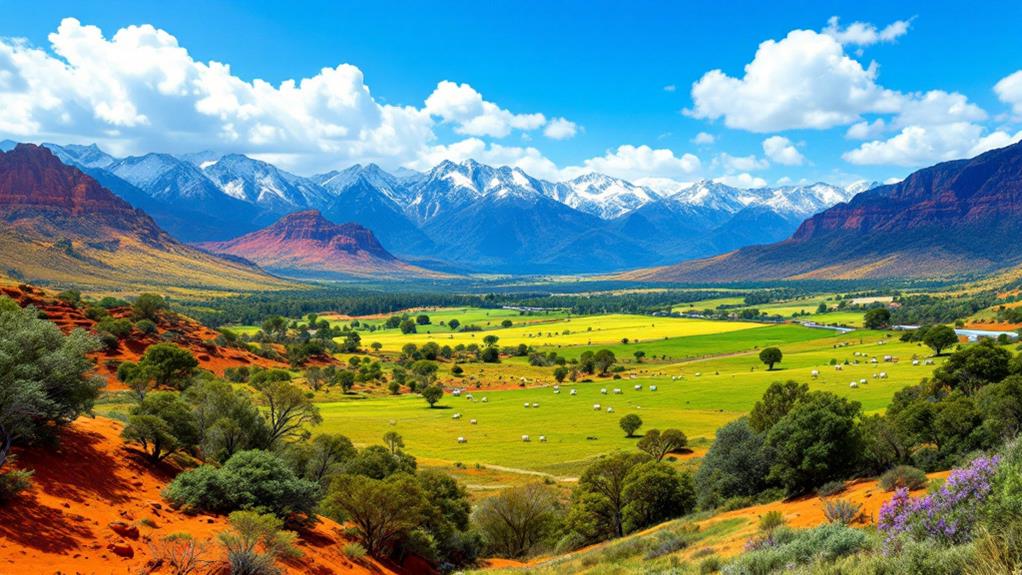What Is the Weather Like in Australia? Climate Overview by Region

You'll find Australia's weather incredibly diverse with distinct climates across its regions. In the south, places like Victoria and Tasmania experience four temperate seasons, while the north, particularly the Top End, has tropical wet and dry seasons, with wet season temperatures soaring above 30°C. Central Australia hosts deserts with intense heat in summer and cold winter nights. On the east coast, cities like Sydney and Melbourne offer lively seasonal changes, while the west enjoys warm, dry weather for a good part of the year. Uncover how this diversity affects travel planning and wildlife habitats across Australia.
Australia's Diverse Climate Zones
Australia's vast landscape is home to a wide array of climate zones, each offering its own unique weather patterns. Being in the southern hemisphere, Australia experiences distinct seasonal variations. The Temperate zone, covering parts of New South Wales, Victoria, Tasmania, and South Australia, enjoys four seasons with summer temperatures ranging from 16°C to 26°C. This zone provides a classic seasonal experience, with warm summers and cool winters, making it quite different from other parts of the country.
In contrast, the Tropical regions, such as the Top End of the Northern Territory, have only two major seasons: wet and dry. The wet season, lasting from November to April, sees temperatures often exceeding 30°C, bringing heavy rains and humidity. Meanwhile, the dry season, from May to October, offers milder weather with temperatures averaging around 20°C, making it a popular time for visitors.
Australia's desert areas are marked by extreme temperature ranges. Summer days can reach up to 40°C, while winter nights can drop below freezing. Grasslands, serving as a changeover zone around deserts, offer milder conditions, especially in areas like the Red Centre and Flinders Ranges.
Weather Patterns in Northern Australia
Venturing into Northern Australia, you'll encounter a climate that's distinctly characterized by its dramatic wet and dry seasons. The wet season, spanning from November to April, brings high humidity and heavy rainfall. Temperatures during this time range from 25°C to 34°C (77°F to 93°F), often exceeding 30°C (86°F). This makes it one of the hottest periods in Northern Australia. Cities like Cairns and Darwin experience this pattern, with Cairns receiving heavy summer rainfall, while Darwin sees significant precipitation during its pronounced wet season.
As you shift into the dry season, from May to October, the weather becomes markedly different. Expect warm, dry days with temperatures generally between 21°C and 32°C (69°F to 89°F), and cooler nights. The humidity drops, offering a more pleasant climate compared to the sticky wet season. In Cairns, autumn and winter bring milder and less humid conditions, making it an ideal time for outdoor activities. Darwin follows a similar pattern, with its dry season providing clear skies and comfortable temperatures.
Understanding these weather patterns helps you plan your visit, ensuring you experience Northern Australia at its finest, regardless of your attraction to the lush, rainy season or the balmy, dry days.
Climate of Western Australia

When you investigate Western Australia, you'll find a climate that varies dramatically across its vast landscapes. The region experiences a dry season from April to September, where average temperatures range from 24°C to 34°C (75°F to 93°F). During this time, the levels of rainfall are minimal, making it an ideal period for outdoor activities. Coastal areas enjoy stable temperatures, but if you venture inland, you might encounter extreme daytime highs reaching up to 40°C (104°F), especially during the summer months.
In contrast, the wet season spans from October to March, bringing higher humidity and temperatures that often climb into the mid to high 30s°C (around 95°F). This period can be quite intense, with increased levels of rainfall, so you ought to prepare for potential tropical storms and heavy downpours. Despite the heat, southern coastal areas maintain an average summer temperature of around 32°C (86°F), while winters here are milder, averaging 14°C (57°F).
Inland, nighttime temperatures can drop considerably, especially during winter, offering a respite from the warm days. This diverse climate guarantees that Western Australia offers a unique experience any time of the year.
East Coast Weather Variability
Exploring the East Coast of Australia reveals a rich tapestry of weather patterns distinct from the varied climates of Western Australia. Here, you'll encounter a mild oceanic climate that offers a pleasant mix of dry and wet conditions. Sydney, for example, enjoys summer temperatures averaging between 25.7-26.5°C (78.3-79.7°F), making it ideal for beach outings. In winter, temperatures remain comfortable, ranging from 17.7-18.4°C (63.9-65.1°F).
Melbourne's weather is known for its variability, often showcasing all four seasons in a single day. Its summer temperatures average between 24.3-25.9°C (75.7-78.6°F), while winters can be quite cool, with temperatures dipping to 6.9°C (44.4°F) at the lowest and peaking at 15.6°C (60.1°F).
Brisbane, on the other hand, offers a warmer climate with summer highs reaching 28.7-29.2°C (83.7-84.6°F) and milder winters averaging 21.3-21.8°C (70.3-71.2°F). The East Coast experiences significant rainfall, especially in Brisbane, where the wet season stretches from October to May, with summer rainfall averaging 126-172mm. Coastal regions maintain milder temperatures and consistent rainfall, creating a temperate paradise for residents and tourists alike.
Southern Australia's Seasonal Changes

Southern Australia offers an enchanting display of seasonal changes, with each season bringing its own unique charm. In summer, from December to February, expect warm temperatures averaging around 28°C, though it can climb above 30°C in some areas. The southern coast benefits from milder temperatures compared to the more extreme inland regions. As temperatures rise, you might enjoy the best of beach days and outdoor activities.
When autumn arrives from March to May, the air cools, and the landscape transforms into a lively tapestry of colorful foliage. This season is the perfect time for exploring the southern regions as nature paints its most picturesque scenes. Winter follows from June to August, with temperatures dipping between 6°C and 14°C. Coastal areas remain milder, but some places experience nighttime lows around 0°C. Rainfall is most significant in winter, so prepare for wetter weather during this season.
Spring, from September to November, brings mild temperatures and blooming flora, making it an excellent time for nature lovers. Cities like Melbourne are famous for experiencing rapid weather changes, where you might encounter all four seasons in a single day, highlighting southern Australia's dynamic climate.
Desert Climate Characteristics
While Southern Australia's seasons offer a tapestry of changing landscapes, the desert regions present a starkly different climate experience. In the heart of Australia, the desert climate is defined by its extreme conditions. You'll encounter high daytime temperatures that can soar up to 50°C during the summer months. These scorching days are followed by nights that can be surprisingly cold, with temperatures dropping below freezing in winter. This stark temperature variation is a hallmark of the desert climate and contributes to its unique biodiversity.
Rainfall in the Australian desert is notoriously unpredictable. You might experience long periods of drought, only to be suddenly interrupted by torrential downpours. These sudden rains can lead to dramatic flooding events. Such conditions have been known to transform dry desert basins into temporary saline lakes, like the renowned Lake Eyre.
The erratic nature of rainfall and severe climate conditions create a challenging environment, yet they also foster a diverse range of ecosystems. You'll be amazed at how life adjusts to thrive amidst these temperature variations and unpredictable weather patterns. The desert climate, though harsh, is a fascinating study of resilience and adaptation.
Weather in Major Cities

As you travel through Australia's major cities, you'll notice the distinct weather patterns that shape each locale's unique atmosphere. In Sydney, summer brings warm weather with temperatures between 25.7 to 26.5°C, while winters are mild, hovering around 17.7 to 18.4°C. You'll also find that summer months receive an average rainfall of 113mm, adding a humid touch to the season.
Melbourne offers a different experience with its pronounced seasonal shifts. Summer temperatures range from 24.3 to 25.9°C, while winters are cooler, averaging 14.6 to 15.6°C. Be prepared for rapid weather changes that can catch you off guard.
In Brisbane, summers are hotter, with the mercury rising to 28.7 to 29.2°C, and winters are quite mild, averaging 21.3 to 21.8°C. Expect substantial rainfall during the summer season.
Perth's weather features hot, dry summers with temperatures from 28.0 to 31.9°C, and mild winters ranging from 18.9 to 22.7°C, with rainfall peaking during cooler months.
Planning a Visit Based on Climate
When planning a visit to Australia, timing is crucial to guarantee you experience the best climate the country has to offer. You'll find that both spring (September to November) and autumn (March to May) are ideal for investigating, as the weather is mild and pleasant across most regions. In the northern parts of Australia, you must consider the wet and dry seasons. The wet season from November to April brings high humidity and heavy rainfall, while the dry season from May to October offers warm, dry days perfect for outdoor activities.
Major cities like Sydney and Melbourne offer distinct seasonal experiences. Summers can be warm, with temperatures ranging from 25°C to 30°C, while winters cool down to around 6°C to 14°C. Coastal regions generally have milder temperatures and more rainfall, which could make them more appealing than the extreme heat of desert areas.
To make the most of your trip:
- Consider visiting during local events and festivals.
- Investigate coastal regions for milder weather.
- Plan your visit to the northern areas during the dry season.
- Enjoy major cities in spring or autumn for more comfortable temperatures.
Researching these aspects will improve your Australian adventure.
Climate Impact on Australian Wildlife

Australia's climate diversity plays a crucial role in shaping its unique wildlife. The country's varied climatic zones, from tropical to desert, influence where animals live and how they behave. You'll find that each species has developed specific adaptations to thrive in their environments. For instance, in the tropical north, the wet season's humidity and lush vegetation attract many animals. However, during the dry season, you might notice wildlife entering dormancy or migrating to find food and water.
In the arid deserts, wildlife has adapted remarkably to extreme temperatures. Many animals are nocturnal, staying active at night to avoid the intense daytime heat. These species rely on the sparse rainfalls for hydration, showcasing their extraordinary resilience. Likewise, Australia's coastal and marine ecosystems, especially around the Great Barrier Reef, support a wide range of marine life. These creatures thrive in warm waters but are sensitive to temperature fluctuations due to climate change.
Seasonal changes also impact wildlife in temperate southern regions. As temperatures drop during winter, breeding cycles and food availability shift. You'll see adaptations in reproductive strategies, ensuring survival despite the challenges posed by the changing climate.
Preparing for Weather Extremes
Understanding how climate shapes wildlife sets the stage for grasping the challenges posed by weather extremes. Australia's diverse climate means you need to be prepared for a variety of weather conditions. In the desert regions, summer temperatures can soar past 40°C (104°F), while winter nights can drop below freezing. Northern Australia, with its high humidity and intense monsoonal rains, experiences temperatures ranging from 25°C to 34°C (77°F to 93°F) during the wet season from November to April.
Here's how you can prepare for these weather extremes:
- Stay Informed: Keep track of weather forecasts and alerts for potential weather extremes in your area.
- Emergency Kit: Have a ready-to-go emergency kit with necessities like water, non-perishable food, and primary aid supplies.
- Plan for Temperature Swings: Be ready for high temperatures and cold nights, especially if you're traveling through desert areas.
- Flood Preparedness: In regions prone to monsoonal rains, have a flood plan, knowing evacuation routes and ensuring your property is protected.
Whether you're dealing with scorching temperatures, heavy rains, or seasonal variations, staying prepared can make all the difference in maneuvering Australia's climate challenges.




